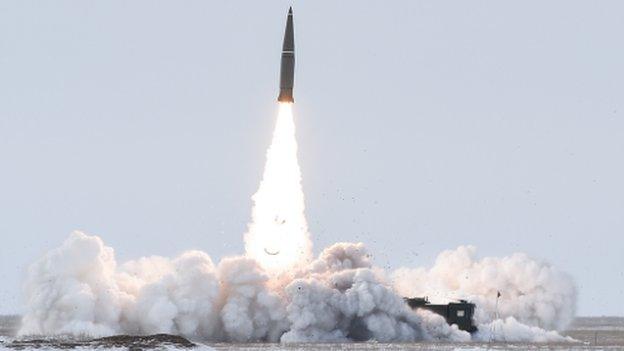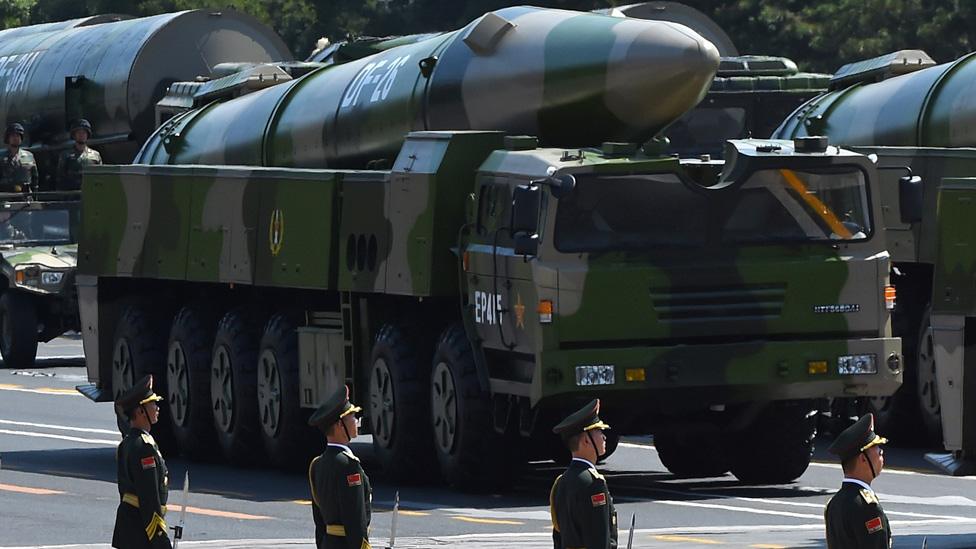The weapons making nuclear war more likely
- Published

The threat of nuclear war fills people with fear. Yet the increasingly blurred line between nuclear and conventional weapons is heightening the danger.
Nuclear and non-nuclear weapons have never been entirely separate from each other.
The B-29 bomber, for example, was designed and built to deliver conventional bombs. But on 6 August 1945 one of these aircraft, Enola Gay, dropped a nuclear weapon on the Japanese city of Hiroshima.
Seventy-four years later, nine countries now possess thousands of nuclear weapons, which are becoming increasingly entangled with non-nuclear weapons.
The global stockpile of nuclear weapons is down from an all-time high of about 64,000 in 1986 - but some contemporary weapons are about 300 times more powerful than the bomb dropped on Hiroshima.

Apart from the UK, all nuclear-armed states possess dual-use weapons that can be used to deliver nuclear or conventional warheads.
These include missiles of ever-longer ranges.
Russia, for example, has recently deployed a new ground-launched cruise missile, the 9M729.
The US believes this missile is dual-use, external and has been tested to distances "well over" 500km (310 miles).
The missile is at the heart of US claims Russia breached the terms of a treaty banning the use of medium- and intermediate-range missiles.
The US has announced its withdrawal from the pact, raising concerns about a new arms race.
China, meanwhile, has recently been showing off its newest missile, the DF-26, external.
Capable of travelling more than 2,500km (1,553 miles), it appears to be the world's longest range dual-use missile capable of a precision strike.

Military vehicles carry DF-26 missiles during a parade in Beijing
There are a number of scenarios in which such missiles could inadvertently increase the chance of a nuclear war.
The most obvious is that in a conflict, they might be launched with conventional warheads but mistaken for nuclear weapons.
This ambiguity could prompt the adversary to launch an immediate nuclear response.
It is difficult to know whether it would choose this course of action - or wait until the weapons had detonated and it became clear how they were armed.
In practice, the greatest danger with dual-use missiles may lie elsewhere: misidentification before they have even been launched.
Imagine that China dispersed lorry-mounted DF-26 missiles loaded with nuclear warheads around its territory.
The US, wrongly believing them to be conventionally armed, might decide to try to destroy them.
By attacking them, it could inadvertently provoke China into launching those nuclear weapons it still had before they could be destroyed.
Satellite systems
Dual-use missiles are not the only way in which nuclear and non-nuclear weapons are increasingly entangled.
For example, all nuclear forces need a communication system - which could include satellites.
But, increasingly, these nuclear command-and-control systems are also being used to support non-nuclear operations.
The US, for example, operates satellites to provide warning of attacks with nuclear-armed or conventionally armed ballistic missiles.

Russia demonstrates its 9M729 missile
In a conflict between Nato and Russia, these could be used to detect short-range conventional ballistic missiles launched by Russia - as the first step towards shooting them down.
If this strategy was successful, Russia could decide to attack the US early-warning satellites in response.
In fact, the US intelligence community has warned, external that Russia is developing ground-based laser weapons for that exact purpose.
But blinding US early-warning satellites would not simply undermine its ability to spot conventionally armed missiles.
It would also compromise the ability of the US to detect nuclear-armed ballistic missiles and could raise fears that Russia was planning a nuclear attack on the US.
Indeed, the latest US Nuclear Posture Review, external - the key official statement of US nuclear policy - explicitly threatens to consider the use of nuclear weapons against any state that attacks its nuclear command-and-control systems.
This threat applies whether or not that state has used nuclear weapons first.
Weapons ban
The governments of nuclear-armed states are presumably aware of the growing entanglement between nuclear and non-nuclear weapons.
They are also aware of at least some of the associated dangers.
However, working to reduce these risks does not seem to be a priority.
The focus remains on enhancing their military capabilities, to deter one another.
One option could be for countries to try to agree a ban on weapons that could threaten nuclear command-and-control satellites.
But for the moment, governments of nuclear-armed states are reluctant to sit around the same table.
As a result, the prospects of such cooperation appear to be bleak.

About this piece
This analysis piece was commissioned by the BBC from an expert working for an outside organisation.
James Acton is a co-director of the Nuclear Policy Program, external at Carnegie Endowment for International Peace. This piece is based on Escalation through Entanglement: How the Vulnerability of Command-and-Control Systems Raises the Risks of an Inadvertent Nuclear War, external. You can follow him on Twitter here, external.

Edited by Duncan Walker